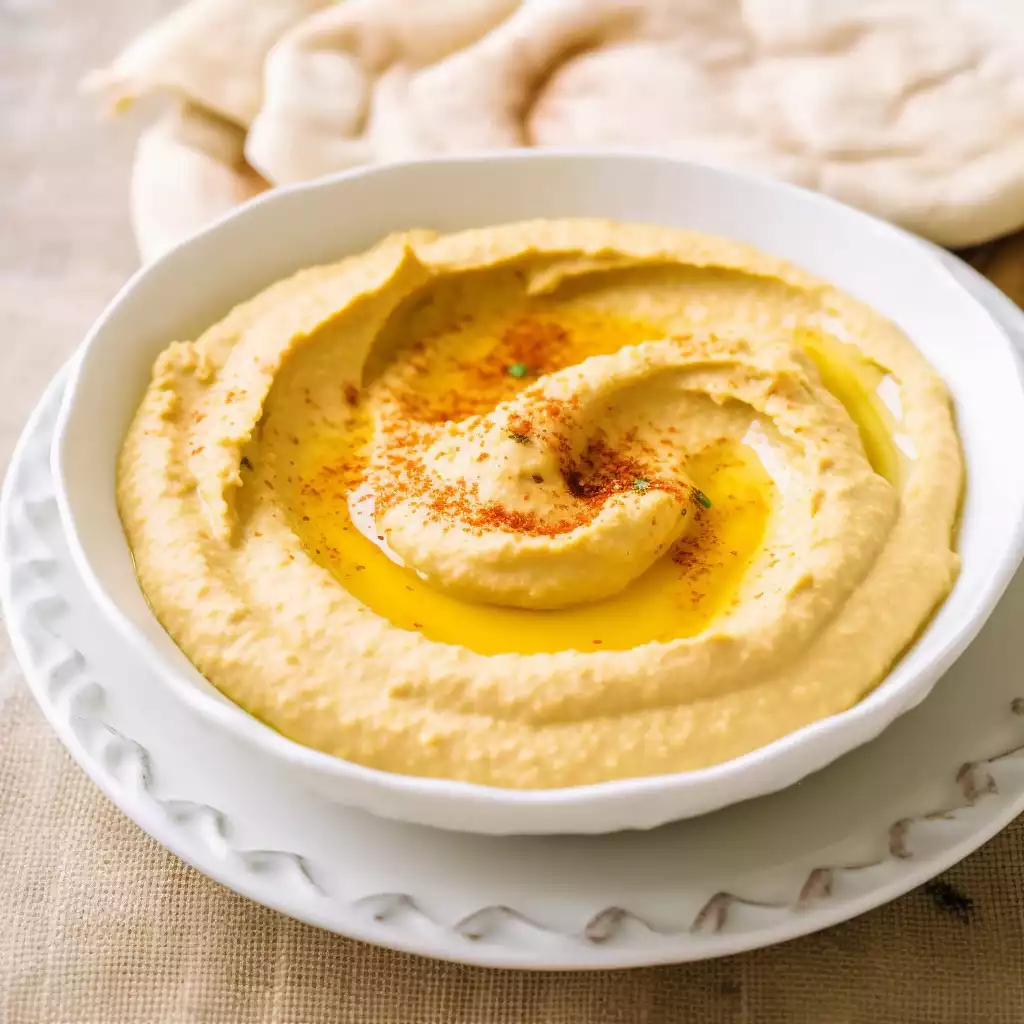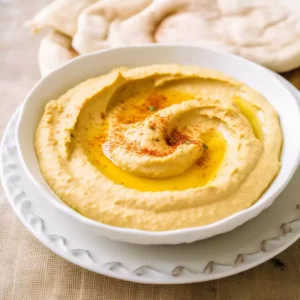
Hummus, a creamy and flavorful dip originating from the Middle East, has gained immense popularity worldwide for its delicious taste and versatility.
This recipe for the best hummus brings together simple yet essential ingredients to create a smooth and satisfying dip that will elevate any meal or snack time.
Crafted with chickpeas, tahini, lemon juice, garlic, and olive oil, this hummus recipe offers a balance of protein, healthy fats, and zesty flavors.
Whether you’re a seasoned cook or just starting your culinary journey, mastering homemade hummus is sure to impress your taste buds and those of your friends and family.
Despite its exotic origins, making hummus at home is surprisingly easy and requires only a few basic steps. With a food processor and a handful of pantry staples, you can whip up a batch of this delectable dip in no time.
Plus, by preparing it yourself, you have full control over the ingredients, ensuring a fresher and healthier alternative to store-bought versions.
Expert Tip: Soaking the chickpeas overnight can help to soften them, making them easier to blend and resulting in a smoother hummus texture.
Chickpeas: These legumes serve as the base of the hummus, providing a creamy texture and nutty flavor. Rich in protein and fiber, chickpeas add substance to the dip, making it satisfying and nutritious.
Tahini: Made from ground sesame seeds, tahini contributes to the smooth consistency of the hummus while imparting a subtle nuttiness. Its creamy texture and earthy taste complement the other ingredients, enhancing the overall flavor profile.
Lemon Juice: The acidity of lemon juice brightens up the hummus, adding a refreshing tanginess that balances the richness of the tahini and olive oil. It also helps to enhance the flavors of the other ingredients, making them more vibrant and harmonious.
Garlic: Minced garlic lends a pungent and aromatic flavor to the hummus, giving it a deliciously savory kick. Its presence adds depth and complexity to the dip, elevating its taste to new heights.
Olive Oil: Extra-virgin olive oil contributes to the creaminess of the hummus while infusing it with a subtle fruity flavor. Rich in monounsaturated fats and antioxidants, olive oil adds a healthy touch to the recipe, making it both indulgent and nutritious.
Salt: A pinch of salt enhances the flavors of the other ingredients, balancing out their taste and intensifying their impact. It helps to bring all the elements of the hummus together, ensuring a well-rounded and satisfying flavor profile.
Paprika, Parsley, and Olive Oil (for serving, optional): These optional garnishes add visual appeal and additional flavor to the hummus, making it even more inviting. A sprinkle of paprika or chopped parsley, along with a drizzle of olive oil, adds a finishing touch that elevates the presentation and taste of the dish.
Expert Tip: Adjust the amount of garlic according to your personal preference. If you prefer a milder garlic flavor, start with one clove and add more to taste.
Expert Tip: For extra flavor, consider adding a pinch of ground cumin or smoked paprika to the hummus mixture before blending.
Homemade hummus can be stored in an airtight container in the refrigerator for up to 4-7 days. Be sure to give it a stir before serving, as the ingredients may separate slightly over time.
Yes, homemade hummus can be frozen for up to 3 months. Transfer it to a freezer-safe container, leaving some room for expansion, and thaw it in the refrigerator overnight before serving. Give it a stir before serving to ensure a smooth consistency.
Yes, you can adjust the consistency of the hummus by adding more or less water while blending. For a thicker hummus, add less water, and for a thinner hummus, add more water until you reach your desired consistency.
Absolutely! Feel free to customize the flavor of the hummus by adding additional ingredients such as roasted red peppers, sun-dried tomatoes, fresh herbs, or spices like cumin or smoked paprika. Get creative and experiment with different flavor combinations to suit your taste preferences.
Tahini is a key ingredient in traditional hummus recipes, as it contributes to the smooth texture and nutty flavor of the dip. However, if you don’t have tahini on hand or prefer to omit it, you can still make a tasty hummus using alternative ingredients such as Greek yogurt or almond butter. Keep in mind that the flavor and texture may vary slightly depending on the substitution used.
Here are some more recipes for you to enjoy! If you my recipes don’t forget to rate and leave a comment.
If you have any recipe suggestions, please do not hesitate to ask me. A great way to stay in contact with me is through Instagram, Facebook, Twitter and YouTube. Don’t forget to tag me @CookwithNabeela in your recipe photos!

Subscribe now to receive my latest recipes directly in your inbox. Stay up-to-date and never miss out!

I love to cook! I want to share with you my favourite, delicious family-friendly recipes. I want to inspire you to create fantastic food for your family every day.
Add your first comment to this post